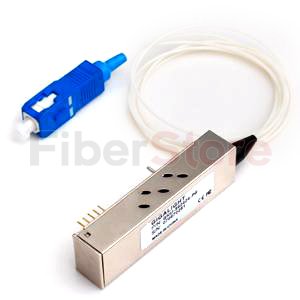PON Transceiver Modules for FTTH
Optical transceivers are classified by wavelengths, data rates, reaches, packaging types, electrical and optical interfaces, temperature ranges, etc. The mannfacturing followings a process from discrete optics to optical subassembly and integrated chips to module assembly and test. There are various optical transceivers currently used with optical access systems. Conventional transceiver technologies based on discrete optoelectronic chips, components, and coaxial packaging are still the key enabler for the industury. The high cost of transceivers is one of the major barriers to mass deployment.

PON transceivers are bidirectional devices that use different wavelengths to transmit and receive signals between an OLT at a central office (CO) and the ONTs at end users' premises. There are currently two standard types of transceivers: the diplexer and the triplexer transceivers, respectively. For the diplexer transceivers, the wavelengths are designed in accordance with industry standards, namely, 1310 nm for the upstream and 1490 nm for the downstream wavelengths. For triplexer transceivers, the 1550 nm wavelength is allocated for analog broadcast video overlay in the downstream direction. It is also possible that digital video signals are carried on the downstream 1490 nm wavelength using video over IP technologies.
For rapid adoption of FTTH, it is important to reduce the cost of optical transceivers. In particular, the overall PON system cost is weigthed more toward the ONU, as the OLT cost is shared among the number of FTTH users. So the ONU transceiver should be the main target for cost reduction whenever possible. In summary, the technological challenges in the optical transceivers for PON systems exist in the following areas:
1. High-output-optical-power and high-sensitivity OLT at the CO to compensate for the losses introduced by the optical splitter and the transmission fibers connecting subscribers' premises.
2. Burst-mode optical transmission technologies for the upstream link.
3. Cost-effective packaging of optical devices.
4. Integration of more digital and analog functions into a single IC.
PON transceivers still represent a very active area in industry research and development due to the huge market opportunity. Because of the PON point-to-multipoint nature, PON burst-mode transceiver must face several unique characteristics to meet the requirements. Despite widespread interest, there is still no related PON transceiver multisource agreement (MSA) defined to support this application. Optical module vendors normally collaborate with system vendors on a case-by-case basis in specifications for diverse systems. Because of the EPON influence, SFF and SFP MSAs gained some popularity, while other form factors like GBIC and proprietary triplexer designs still exist for this application.
From the EPON/G-PON system compatibility and reusability viewpoint, transceiver modules can be split into blocks of BOSA, electrical subassembly (ESA), housing, and thermal management. The BOSA module must satisfy transmitter optical power, and receiver sensitivity, etc. Considerations on the ESA side include burst-mode physical-media-dependant (PMD) drving performances, system control signal acceptable, high receiver sensitivity, and receiver circuits also need to be examined. One most important aspect is the specific testing items such as transmitter ON/OFF time and receiver settling time. It is of key importance for system designers to maintain system performance and utilize system data processing ability. On the mechanical side, many critical issues need to be considered, such as thermak, EMI, temperature, humidity effect, etc.
Besides the PON transceivers, the biggest Chinese transceiver modules manufacturer FiberStore also provides SFP port to RJ45 Netgear and Netgear SFP+ module such as 10GbASE-LR SFP+ module Netgear.